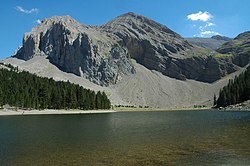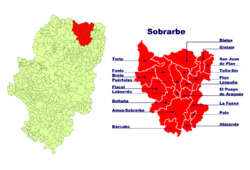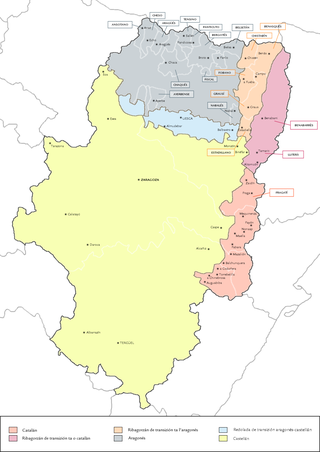
Aragonese is a Romance language spoken in several dialects by about 12,000 people as of 2011, in the Pyrenees valleys of Aragon, Spain, primarily in the comarcas of Somontano de Barbastro, Jacetania, Alto Gállego, Sobrarbe, and Ribagorza/Ribagorça. It is the only modern language which survived from medieval Navarro-Aragonese in a form distinct from Spanish.
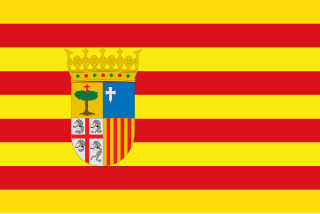
Aragon is an autonomous community in Spain, coextensive with the medieval Kingdom of Aragon. In northeastern Spain, the Aragonese autonomous community comprises three provinces : Huesca, Zaragoza, and Teruel. Its capital is Zaragoza. The current Statute of Autonomy declares Aragon a historic nationality of Spain.

Benabarre, in Ribagorçan and Aragonese: Benavarri is a town and municipality in the Aragonese comarca of Ribagorza, in the province of Huesca, Spain.

Ramiro I was the first King of Aragon from 1035 until his death, although he is sometimes described as a petty king. He would expand the nascent Kingdom of Aragon through his acquisition of territories, such as Sobrarbe and Ribagorza, and the city of Sangüesa. Sancho Ramírez, his son and successor, was King of Aragon, but also became King of Pamplona.

The County of Ribagorza or Ribagorça was a medieval county on the southern side of the Pyrenees, including the northeast of modern Aragón and part of the northwest of modern Catalonia, both in Spain. It was originally the independent creation of a local dynasty, later absorbed into the Kingdom of Navarre and then into the Crown of Aragon. It had a strong historical connection with the neighboring counties of Sobrarbe and Pallars. Its territory consisted of the valleys of the rivers Ésera, Isábena, and Noguera Ribagorzana. The seat of its counts was at Benabarre. Other notable towns include Benasque, Graus and Pont de Suert. Today the western portion of the county roughly corresponds to the Aragonese comarca of Ribagorza, with its administrative centre in Graus; the eastern portion roughly corresponds to the Catalan comarca of Alta Ribagorça.

Huesca, officially Huesca/Uesca, is a province of northeastern Spain, in northern Aragon. The capital is Huesca.
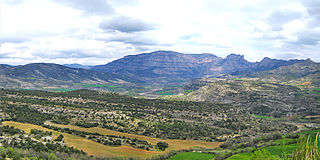
Ribagorça or Ribagorza is a historical and natural region of Aragon and Catalonia. Located in the Pre-Pyrenees and Pyrenees area, most of its territory is mountainous. The region has been steadily losing population since mid 20th century.
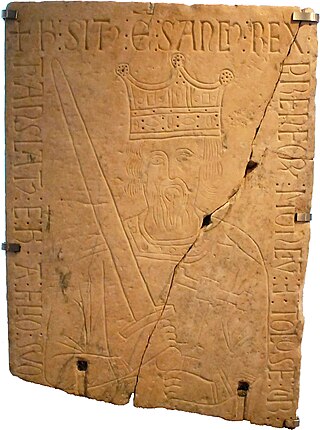
Sancho Garcés III, also known as Sancho the Great, was the King of Pamplona from 1004 until his death in 1035. He also ruled the County of Aragon and by marriage the counties of Castile, Álava and Monzón. He later added the counties of Sobrarbe (1015), Ribagorza (1018) and Cea (1030), and would intervene in the Kingdom of León, taking its eponymous capital city in 1034.

The Kingdom of Aragon was a medieval and early modern kingdom on the Iberian Peninsula, corresponding to the modern-day autonomous community of Aragon, in Spain. It was part of the larger Crown of Aragon, which also included other territories—the Principality of Catalonia, the Kingdom of Valencia, the Kingdom of Majorca, and other possessions that are now part of France, Italy, and Greece—that were also under the rule of the King of Aragon, but were administered separately from the Kingdom of Aragon.

Gonzalo Sánchez was the king of Sobrarbe and Ribagorza, two small Pyrenean counties, from 1035 until his death. He was the son of King Sancho III of Navarre and his wife, Muniadona of Castile. Before his death in 1035, Sancho divided his kingdom between his sons, leaving Sobrarbe and Ribagorza to Gonzalo. He governed them as vassal of his elder brother, García Sánchez III, who had inherited Navarre. Gonzalo is thought to have been ineffectual and unpopular, with vassals defecting to his half-brother, Ramiro I of Aragon, during his own lifetime. Within a decade of his death, his reign was being ignored and he was left out of a list of rulers of Ribagorza.

The Jiménez dynasty, alternatively called the Jimena, the Sancha, the Banu Sancho, the Abarca or the Banu Abarca, was a medieval ruling family which, beginning in the 9th century, eventually grew to control the royal houses of several kingdoms on the Iberian Peninsula during the 11th and 12th centuries, namely the Kingdoms of Navarre, Aragon, Castile, León and Galicia as well as of other territories in the South of France. The family played a major role in the Reconquista, expanding the territory under the direct control of the Christian states as well as subjecting neighboring Muslim taifas to vassalage. Each of the Jiménez royal lines ultimately went extinct in the male line in the 12th or 13th century.

The County of Aragon or County of Jaca was a small Frankish marcher county in the central Pyrenean valley of the Aragon river, comprising Ansó, Echo, and Canfranc and centered on the small town of Jaca, an area now part of Spain. It was created by the Carolingians late in the 8th or early in the 9th century, but soon fell into the orbit of the Kingdom of Navarre, into which it was absorbed in 922. It would later form the core of the 11th century Kingdom of Aragon.

Aínsa is the main town in the Aínsa-Sobrarbe municipal territory, Aragon, Spain.

Aínsa-Sobrarbe is a municipality located in the province of Huesca, Aragon, Spain. As of 2010 (INE), the municipality has a population of 2,180 inhabitants.

Boltaña is a municipality located in the province of Huesca, Aragon, Spain. According to the 2004 census (INE), the municipality has a population of 870 inhabitants.

Somontano de Barbastro is a comarca in Province of Huesca, Aragon, Spain.

The Kingdom of Sobrarbe was the legendary predecessor to the Kingdom of Aragon and the modern region of Sobrarbe. According to the late medieval legend, the kingdom, with its capital at Aínsa, was a product of the Reconquista. The legend is based in part on the historical origins of the Kingdom of Pamplona.
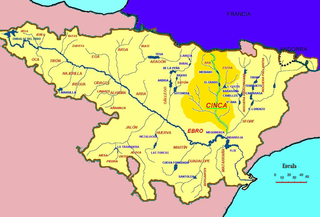
On 25 December 1084, at the Battle of Piedra Pisada, the Taifa of Zaragoza fought and probably defeated the Kingdom of Aragon on the road south from Naval to El Grado. The battle was a minor engagement of the ongoing Reconquista of Aragon, the process by which the riverine valleys of the southern slopes of the Pyrenees were gradually conquered and returned, after centuries of Muslim rule, to the control of Christian princes. The ruler of Aragon, who personally led his men in battle at Piedra Pisada, Sancho Ramírez, also ruled Kingdom of Navarre and was a major figure in the contemporary Reconquista.

Ribagorza or Ribagorça is a comarca in Aragon, Spain, situated in the north-east of the province of Huesca. It borders the French département of the Haute-Garonne to the north and Catalonia to the east. Within Aragon its neighboring comarcas are Sobrarbe, Somontano de Barbastro, and La Litera. It roughly corresponds to the Aragonese part of the medieval County of Ribagorza. The administrative capital of Ribagorza is Graus, although the historical capital of the county was at Benabarre.

The Peña Montañesa is a conspicuous rocky mountainous outcrop of the Pre-Pyrenees. It is located east of the valley of the Cinca, in the Sobrarbe comarca, Aragon, Spain. The ridge's highest summit is 2295 m high. The village of Laspuña is located at the feet of the mountain.
